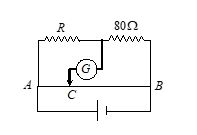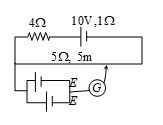Q.1
In the circuit shown, a meter bridge is in its balanced state. The meter bridge wire has a resistance 0.1 ohm/cm. The value of unknown resistance X and the current drawn from the battery of negligible resistance is

(a) 6W, 5 amp
(b) 4W, 0.1 amp
(c) 4W, 1.0 amp
(d) 12W, 0.5 amp
Ans : c
Q.2
AB is a wire of uniform resistance. The galvanometer G shows zero current when the length AC= 20 cm and
CB = 80 cm. The resistance R is equal to

(a) 2 W
(b) 8 W
(c) 20 W
(d) 40 W
Ans. (c)
Q.3
In the shown arrangement of the experiment of the meter bridge if AC corresponding to null deflection of galvanometer is x, what would be its value if the radius of the wire AB is doubled?

(a) x
(b) x/4
(c) 4x
(d) 2x
Ans. (a)
Q.4
A galvanometer of resistance 19.5 W gives full scale deflection when a current of 0.5 ampere is passed through it. It is desired to convert it into an ammeter of full scale current 20 ampere. Value of shunt is
(a) 0.5 W (b) 1 W (c) 1.5 W (d) 2 W
Ans : (a)
Q.5
An ammeter is obtained by shunting a 30 W galvanometer with a 30W resistance. What additional shunt should be connected across it to double the range?
(a) 15 W (b) 10 W (c) 5 W (d) none of these
Ans : (a)
Q.6
A galvanometer of 10 ohm resistance gives full scale deflection with 0.01 ampere of current. It is to be converted into an ammeter for measuring 10 ampere current. The value of shunt resistance required will be
(a) \frac{{10}}{{999}}ohm
(b) 0.1 ohm
(c) 0.5 ohm
(d) 1.0 ohm
Ans : (a)
